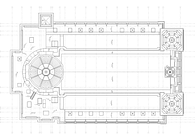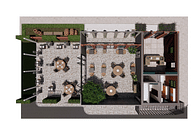
Alterpex took on the challenge of scanning and documenting the existing conditions of a commercial retail and office building. Using advanced scanning technology, Alterpex captured accurate data of the building’s current layout, focusing specifically on documenting the visible framing. This detailed information is critical for understanding the structural aspects that may impact future renovation work.
Beyond data collection, Alterpex created an immersive virtual 360-degree walkthrough tour, or digital twin, of the space. This tour allows stakeholders to explore the building virtually, giving a realistic view of each area without needing to be on-site. It’s an efficient tool for architects, designers, and planners, providing them with a complete digital reference.
In addition, Alterpex developed a 3D Revit model accompanied by a full set of as-built plans. These plans capture every dimension, structural element, and architectural detail needed for renovation planning, ensuring accuracy and reducing the chance of costly errors. With this comprehensive approach, Alterpex made it easier for the renovation team to understand the building inside and out before beginning any physical work.
Project Details
Building Area 6,505 sf
2 Baths
Complete As-Built Set of Plans
Full Interior & Exterior Point Cloud
360 Virtual Tour
3D Revit Model & CAD drawings
Read more about the project https://alterpex.com/projects/retail
What Is Revit Modeling?
A 3D Revit model is a digital replica of a building or space created using Autodesk Revit software. It’s not just a basic 3D image—it’s a highly detailed model that includes architectural, structural, and engineering elements. This model gives you a comprehensive view of a building's layout, including walls, windows, plumbing, electrical systems, and more.
Unlike traditional blueprints, a 3D Revit model allows you to explore the design from any angle. You can walk through rooms, inspect different components, and make changes directly in the model, all before construction even starts. This makes it an invaluable tool for architects, engineers, and contractors, as it helps catch potential issues early, improving accuracy and saving time and money.
The 3D Revit model also makes collaboration easier. Project teams can share and update the model in real-time, keeping everyone on the same page and reducing misunderstandings.
What is Digital Twin?
A digital twin is a virtual representation of a real-world object or space, created using data from the physical environment. This model is more than just a static image—it’s a dynamic tool that updates as the real-world counterpart changes. By using point clouds from 3D scans, the digital twin captures every detail, making it as close to the actual object as possible.
Point clouds play a key role in creating digital twins. They consist of millions of data points that map out precise dimensions, shapes, and spatial details of a building or site. These point clouds are then converted into a highly accurate, 3D digital model, which anyone can explore from anywhere.
With a digital twin, you can anticipate issues, run simulations, and make informed decisions without physically being on-site. This technology saves time, cuts costs, and gives teams the power to manage projects efficiently.
Status: Built
Location: Hayward, CA, US










